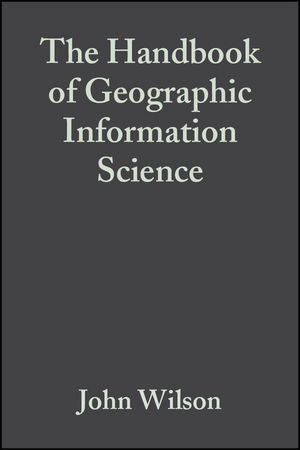The Handbook of Geographic Information ScienceISBN: 978-1-4051-0795-2
Hardcover
652 pages
August 2007, Wiley-Blackwell
 This is a Print-on-Demand title. It will be printed specifically to fill your order. Please allow an additional 10-15 days delivery time. The book is not returnable.
Other Available Formats: Paperback
|
||||||
List of Contributors.
Preface.
Geographic Information Science: An Introduction: A. Stewart Fotheringham (National University of Ireland) and John P. Wilson (University of Southern California).
Part I: Data Issues:.
1. The Availability of Geographic Data: The Current Technical and Institutional Environment: David J. Cowen (University of South Carolina).
2. Social Data: David J. Martin (University of Southampton).
3. Remote Sensing: Brian G. Lees (University of New South Wales).
4. Spatialization: Andre Skupin (San Diego State University) and Sara I. Fabrikant (University of Zurich).
5. Uncertainty in Spatial Databases: Ashley Morris (DePaul University).
6. On the Identification of Uncertainties in Spatial Data and Their Quantification with Probability Distribution Functions: James D. Brown (Universiteit van Amsterdam) and Gerald B. M. Heuvelink (Wageningen University and Research Centre).
Part II: Database Trends and Challenges:.
7. Object-Oriented Database Management Systems: Shashi Shekhar and Ranga Raju Vatsavai (University of Minnesota).
8. Adding the Z Dimension: Michael F. Hutchinson (Australian National University).
9. Adding Time into Geographic Information Science Databases: May Yuan (University of Oklahoma).
10. Geospatial Data Integration: Craig A. Knoblock and Cyrus Shahabi (University of Southern California).
Part III: Visualization:.
11. Mapping in a Digital Age: William E. Cartwright (RHIT University).
12. Generalization of Spatial Databases: William A. Mackaness (University of Edinburgh).
13. Geographic Information Science and Surfaces: Nicholas J. Tate (University of Leicester), Peter F. Fisher (City University), and David J. Martin (University of Southampton).
14. Fuzzy Classification and Mapping: Vincent B. Robinson (University of Toronto).
15. Rule-Based Mapping: A-Xing Zhu (University of Wisconsin).
16. Multivariate Geovisualization: Mark Gahegan (Pennsylvania State University).
17. Virtual Reality in Geographic Information Science: Michael Batty (University College London).
Part IV: Knowledge Elicitation:.
18. Inference and Spatial Data: Chris Brunsdon (University of Leicester).
19. Geographic Data Mining and Knowledge Discovery: Harvey J. Miller (University of Utah).
20. The Geospatial Semantic Web: Frederico Fonseca (Pennsylvania State University).
Part V: Spatial Analysis:.
21. Quantitative Methods and Geographic Information Systems: Martin Charlton (National University of Ireland).
22. Spatial Cluster Analysis: Geoffrey M. Jacquez (BioMedware, Inc., Ann Arbor).
23. Terrain Analysis: Yongxin Deng (Western Illinois University), John P. Wilson (University of Southern California), and John C. Gallant (CSIRO Land and Water, Canberra).
24. Dynamic Modeling: Jochen Albrecht (City University of New York).
Part VI GIS and Society:.
25. Institutional Geographic Information Science and GI Partnering: David Tulloch (State University of New Jersey).
26. Participatory Geographic Information Science: Daniel Weiner and Trevor M. Harris (West Virginia University).
27. Geographic Information Science and Participatory Decision Making: Piotr Jankowski (San Diego State University) and Timothy L. Nyerges (University of Washington).
28. Surveys of People and Place: Peter H. Dana (Georgetown).
29. Geographic Information, Personal Privacy, and the Law: George C. H. Cho (University of Canberra).
30. Geographic Information in Education: Joseph J. Kerski (Denver Federal Center).
Part VII: Future Trends and Challenges:.
31. Web-based Geographic Information Science: Christopher B. Jones (Cardiff University) and Ross S. Purves (University of Zurich).
32. Location-based Services and Geographic Information Science: Allan J. Brimicombe (University of East London).
33. Geographic Information Science: The Grand Challenges: Michael F. Goodchild (University of California).
34. Geographic Information Science: Where Next?: Andreas Reuter (European Media Laboratory, Heidelberg) and Alexander Zipf (University of Applied Sciences FH Mainz).
Index



